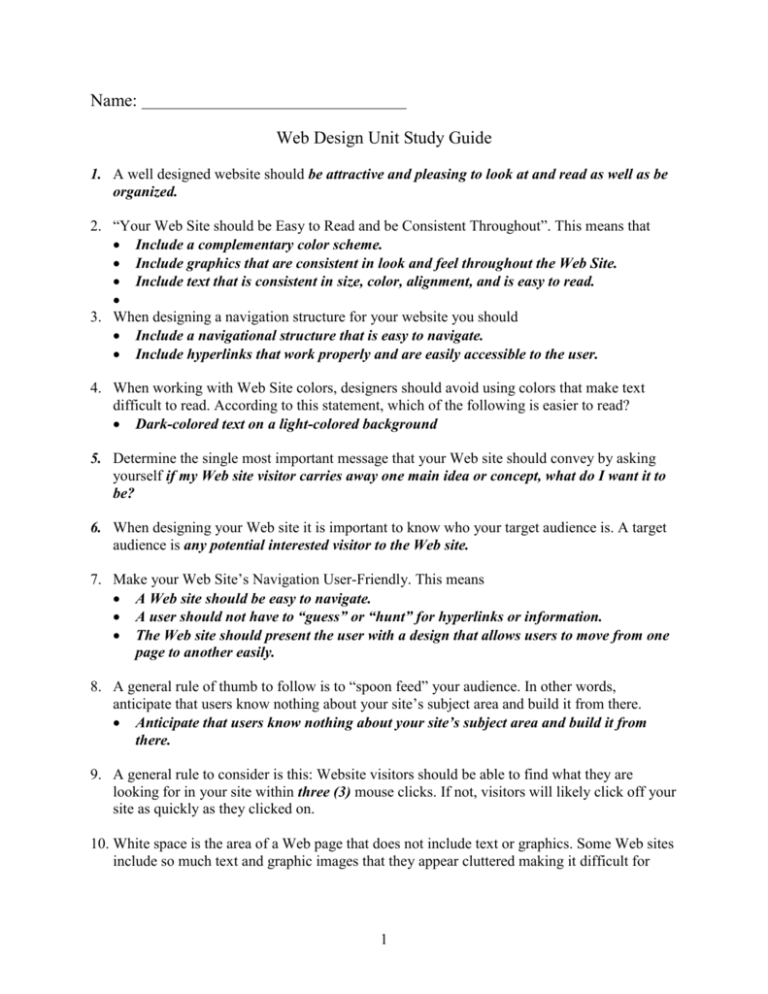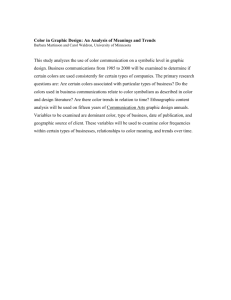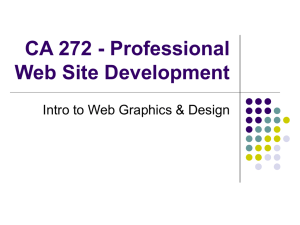Web Design Unit Study Guide
advertisement

Name: Web Design Unit Study Guide 1. A well designed website should be attractive and pleasing to look at and read as well as be organized. 2. “Your Web Site should be Easy to Read and be Consistent Throughout”. This means that Include a complementary color scheme. Include graphics that are consistent in look and feel throughout the Web Site. Include text that is consistent in size, color, alignment, and is easy to read. 3. When designing a navigation structure for your website you should Include a navigational structure that is easy to navigate. Include hyperlinks that work properly and are easily accessible to the user. 4. When working with Web Site colors, designers should avoid using colors that make text difficult to read. According to this statement, which of the following is easier to read? Dark-colored text on a light-colored background 5. Determine the single most important message that your Web site should convey by asking yourself if my Web site visitor carries away one main idea or concept, what do I want it to be? 6. When designing your Web site it is important to know who your target audience is. A target audience is any potential interested visitor to the Web site. 7. Make your Web Site’s Navigation User-Friendly. This means A Web site should be easy to navigate. A user should not have to “guess” or “hunt” for hyperlinks or information. The Web site should present the user with a design that allows users to move from one page to another easily. 8. A general rule of thumb to follow is to “spoon feed” your audience. In other words, anticipate that users know nothing about your site’s subject area and build it from there. Anticipate that users know nothing about your site’s subject area and build it from there. 9. A general rule to consider is this: Website visitors should be able to find what they are looking for in your site within three (3) mouse clicks. If not, visitors will likely click off your site as quickly as they clicked on. 10. White space is the area of a Web page that does not include text or graphics. Some Web sites include so much text and graphic images that they appear cluttered making it difficult for 1 users to navigate and understand the main points of the Web site. A general rule of thumb is to: Include enough white space between text and images to allow users to read and “breath” between different elements on your Web pages. 11. The size of a user’s Web browser window is probably one of the biggest headaches a Web designer will encounter. This is because Not everyone has the same size monitor running at the same resolution. Different Internet browsers have different viewable screen areas. 12. The most commonly used monitor screen resolution size is 1024 X 768 Pixels. 13. One way to give you more control over the layout and make your Web page design more interesting is to use tables. 14. Tables can be used to control many aspects of the Web page. They can be used to Place text into columns, images next to text Navigational buttons in rows or columns Control the layout of your Website. 15. Keep Text Consistent Throughout Your Web Site Do not make your text too small or too large, Avoid using a text size smaller than 8 pts or larger than 14 pts. Text that is too small is hard to read and text too large will give the appearance that you are “Shouting” at your visitors. Keep the alignment of the body text to the left, not centered; Center-aligned text is best used in headlines. You want your visitors to be comfortable wit what they are reading, and the standard format that people are accustomed to reading is left-aligned Include enough white space according to the size of your page. 16. Before you begin designing your Web site, take the time to visit other similar Web sites. Compare and contrast the different layout, text, graphics, and color scheme used This will help you to establish a Web site design structure that is compatible with the rest of the industry. 17. Text links should be unique and not look the same as any other text in your Web pages. A standard rule will keep this from happening. Since most hyperlinked text appears as an underlined typestyle, avoid underlining any text in your Web site (unless it is a hyperlink). Make the color of hyperlinked text different than non-linked text to avoid confusing your visitors. 18. When businesses communicate by means of a Web site, they rely heavily on the site’s Look and design to convey their intended message and identity to users. 2 19. Noting spoils a well-designed Web page more than a typo. When you are nearing the completion of each Web page, take the time to proofread it for spelling, grammar, and design. Check capitalization and punctuation as well. Ask yourself the following: Are there any words misspelled? Do the sentences make sense? Did you leave out any required text or design elements? 20. Use a maximum of 2 to 3 colors throughout your Web site. One color should be the dominant color and the other an accent color. 1. The JPEG format is usually used for photos where there are lots of subtle color changes and detail. 2. The GIF format is usually best suited for graphics that have mainly flat colors. 3. GRAPHIC IMAGES help illustrate a Web page’s message. 4. Create a COLOR SCHEME that coordinates with your Web site's overall message. 5. After you review the content of your Web site, you need to decide on the framework or structure of the site and how it is all going to fit together. In the field of WEB DESIGN, this is commonly referred to as Web site ARCHITECTURE or structure. 1. Keep the color of your text consistent throughout your Web site. If you use one color for headlines and another for body text, keep this color scheme the same on all Web pages. 2. A good piece of advice is to have more than 1 or 2 people review your Web site. They will often find an error or omission that you did not see. 3. The different colors you see displayed on a Web page are made by mixing 3 colors: Red, Green, and Blue. These color mixes are commonly referred to as RGB. 4. Designing a Web site is much like writing an essay. It doesn’t always come out right the first time around. You may have to revise it several times in order to get it right. 5. The most common graphic formats supports by Web browsers for graphics are GIF and JPEG’s. 3 Open Ended Questions: 1. What colors would you pick if you were asked to design a Web site for a company that sells cotton candy? Explain. The colors pink and white come to mind to reflect the color of the cotton candy and the white cone used to hold it. 2. The guidelines for working with website colors say to use a maximum of 2 or 3 colors throughout your Web site. One color should be the dominant color and the other an accent color. How would you use the color scheme to paint a house to illustrate this concept? To illustrate this, think of the color scheme used to paint a house. The body of the house is usually painted one color (the dominant color), the trim or window shutters are usually painted a different color (the accent color). The same philosophy should be applied to your Web site’s color scheme. 3. When in Doubt – Apply the “KIS” Rule. What does this mean? What does “KIS” stand for? This rule is simple. If you are spending too much time pondering over using one graphic image versus another, or haggling over selecting a particular background color of a table, then “KIS”. A common principle used by designers, “KIS” is an acronym that stands for “Keep It Simple”. If for instance, you are debating over whether or not to change the color of text from the default of black to a different color, keep the text black 4. Why is it always good to have a paper plan of your website first before you actually start building it? One of the worst habits you can develop as a Web site designer is to start building your Web site without first planning its design on paper. It is much easier to develop different design concepts and layout schemes on paper than it is on the computer. 4








